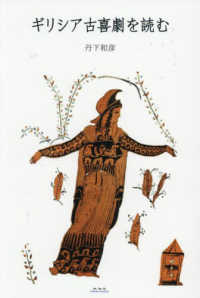- ホーム
- > 洋書
- > 英文書
- > Science / Mathematics
Full Description
The increasing environmental and health concerns owing to the use of large quantities of water and hazardous chemicals in conventional textile finishing processes has lead to the design and development of new dyeing strategies and technologies.Sustainable Practices in the Textile Industry comprises 13 chapters from various research areas dealing with the application of different sustainable technologies for enhancing the dyeing and comfort properties of textile materials with substantial reduction in wastewater problems. Chapters focus on the sophisticated methods for improving dye extraction and dyeing properties which will minimize the use of bioresource products. This book also brings out the innovative ways of wet chemical processing to alleviate the environmental impacts arising from this sector. This book also discusses innovations in eco-friendly methods for textile wet processes and applications of enzymes in textiles in addition to the advancements in the use of nanotechnology for wastewater remediation.
Contents
Preface xvPart 1: Sustainable Dye Extraction and Dyeing Techniques 11 Extraction and Application of Natural Dyes 3Sanjeeda Iqbal and Taiyaba Nimra Ansari1.1 Introduction 41.2 What are Natural Dyes? 61.3 Why Natural Dyes? 71.4 What are Synthetic Dyes? 81.5 Sources of Natural Dyes 91.6 Types of Natural Dyes 101.6.1 Classification on the Basis of Their Chemical Constitution 101.6.2 Classification Based on Method of Application/Preparation 111.7 Natural Dyes Need Fixing Agent (Mordants) for Bonding 131.7.1 Metallic Mordants 131.7.2 Tannins and Tannic Acid 141.7.3 Oil Mordants 141.7.4 Bio-Mordants 141.7.5 Method of Application 161.8 Fibers/Fabrics Used for Natural Dyeing 161.8.1 Cellulosic Fiber 161.8.2 Protein Fiber 161.8.3 Synthetic Fiber 171.9 Extraction of Natural Dyes 171.10 Dyeing Process 181.10.1 Preparation of Fabric Before Dyeing 181.10.2 Mechanism of Dyeing 191.10.3 Process of Dyeing 191.11 Evaluation of the Dyed Fabric 241.11.1 Color Strength or K/S Value 241.11.2 Color Fastness Properties 251.12 Some Special Characteristics of Naturally Dyed Fabric 261.12.1 Antimicrobial Properties 261.12.2 UV Protection 261.12.3 Deodorizing Finishing 271.12.4 Moth Resistant and Insect Repellent 271.13 Conclusion 271.13.1 Overview 291.13.2 Legislative Regulations for Synthetic Dyes 301.13.3 Sustainability Aspects of Natural Dyes 301.13.4 Practicality of Natural Dyes 32Acknowledgement 32References 332 Recent Advances in Non-Aqueous Dyeing Systems 43Omer Kamal Alebeid, Elwathig A.M. Hassan and LiujunPei2.1 Introduction 432.2 Supercritical Fluid Dyeing System 442.2.1 Application of Supercritical CO2 on Synthetic Fabric 462.2.2 Application of Supercritical CO2 on Natural Fabric 482.2.3 Dyes Solubility in Supercritical Fluids 562.3 Reverse Micelle Systems 572.3.1 Mechanism and Formation of Reverse Micelle 572.3.2 Application of Reverse Micelle Dyeing System 592.4 Solvent Dyeing 612.5 Silicone Non-Aqueous Dyeing 622.6 Conclusion 68References 683 Structural Coloration of Textile Materials 75Showkat Ali Ganie and Qing Li3.1 Introduction 753.2 Thin-Film Interference 773.2.1 Principle of Thin-Film Interference 783.2.2 Multilayer Interference 79References 844 Enzymatic Wet Processing 87Mohammad Toufiqul Hoque, Nur-Us-Shafa Mazumder and Mohammad Tajul Islam4.1 Introduction 874.2 Enzymes 894.3 Function of Enzymes 894.4 Classification of Enzymes 894.5 n-Amylase Enzyme for Desizing 924.6 Pectinase Enzyme for Scouring 934.7 Protease Enzyme for Wool Anti-Felting 944.8 Cellulase Enzyme for Biopolishing and Biostoning 964.9 Hairiness Removal Mechanism 984.9.1 During Scouring and Bleaching in Alkaline Condition 984.9.2 Applying Before Dyeing in Acidic Condition 994.10 Enzyme Decolorization of Textile Effluent 1004.11 Enzymes for Increasing Dyeability of Different Fibers 1014.11.1 Application on Cotton 1014.11.2 Application on Nylon 1034.12 Conclusion 104References 105Part 2: Sustainable Functional Finishing of Various Textile Materials 1115 Coating Textiles: Towards Sustainable Processes 113Imene Ghezal5.1 Introduction 1145.2 Most Used Polymers for Coating Textiles 1145.2.1 Polytetrafluoroethylene (PTFE) 1145.2.2 Polyvinyl Acetate (PVAc) 1155.2.3 Polyvinyl Alcohol (PVA) 1165.2.4 Polyurethanes (PUs) 1165.2.5 Polyvinyl Chloride (PVC) and Polyvinylidene Chloride (PVDC) 1165.2.6 Polysiloxanes 1185.2.7 Acrylics 1185.2.8 Phosphorous-Based Polymers 1185.3 Traditional Coating Methods 1185.4 Environmental Friendly Polymers 1215.4.1 Cyclodextrins 1215.4.2 Chitin and Chitosan 1235.4.3 Sodium Alginate 1235.4.4 Polyethylene Glycols 1245.4.5 Natural Rubber 1255.4.6 Polyvinyl Alcohol 1265.4.7 Dendrimers 1275.4.8 Sericin 1275.4.9 Polyphenols 1285.5 Sustainable Coating Technologies 1295.5.1 Powder Coating Technique 1295.5.2 Sol-Gel Technology 1305.5.3 Plasma Treatment 1315.5.4 Electro-Fluidodynamic Technology 1325.5.5 Supercritical Fluid Technology 1335.5.6 Vapor Deposition Methods 1345.6 Conclusion 135References 1366 A Review on Hydrophobicity and Fabricating Hydrophobic Surfaces on the Textiles 149Mohammad Khajeh Mehrizi and Zahra Shahi6.1 Introduction 1496.2 Self-Cleaning Surfaces 1516.3 Applications of Hydrophobic Surfaces 1516.4 Basic Theories: Modeling of Contact Angle 1526.4.1 Young's Model 1526.4.2 Wenzel Model (Homogeneous Interface) 1526.4.3 Cassie-Baxter Model (Composite Interface) 1536.5 Techniques to Make Super-Hydrophobic Surfaces 1546.6 Methods of Applying Hydrophobic Coating on Textiles 1566.6.1 Dip-Coating 1566.6.2 Spray Coating 1566.7 Contact Angles (CA) Measurement 1566.8 Research Records on Hydrophobic Surface Production 1576.9 Conclusion 162References 1637 UV Protection: Historical Perspectives and State-of-the-Art Achievements 167Narcisa Vrinceanu and Diana Coman7.1 Introduction 1677.2 Fundamentals Regarding UV Protection of Textile Fabrics 1697.2.1 The Design of the Woven Support Represents a Relevant Factor That Directly Affect UPF 1717.2.2 The Synergism Between Structural Parameters and UV Protection of Textile Supports 1727.2.3 Yarn Curve End up Being the Significant Determinant of the UV Security Attributes of Textile Supports 1727.2.4 The Correlation Between Fabric Porosity and Cover Factor and UV Protection 1727.2.5 Concepts of Ultraviolet Protection Factor and Sun Protection Factor 1737.3 UV Stabilizers Beginnings and Initial Development 1787.3.1 UV Protection Finishing of Fabrics Using Nanoparticles 1787.3.1.1 Inorganic Formulations With Nano-ZnO Particles 1787.3.1.2 UV Shield of Cotton Support Conferred by TiO2 Nanoparticles 1797.3.1.3 Formulations Containing Nanoparticles of ZnO, Titania, Silica, Silver, Carbon-Nanotubes, Graphene and Silver Onto Cotton Textiles 1807.3.2 UV Protection of Fabrics by Dyeing of Textile Supports 1817.3.3 Other Kind of Finishes 1827.4 Conclusion 182References 1888 Synthetic and Natural UV Protective Agents for Textile Finishing 207Iftay Khairul Alam, Nazia Nourin Moury and Mohammad Tajul Islam8.1 Introduction 2078.2 Ultraviolet Radiation (UVR) 2088.3 Importance of Ultraviolet Protective Finish 2098.3.1 Ultraviolet Protection With Textiles 2118.4 Methods of Blocking Ultraviolet Rays 2128.5 Ultraviolet Protection Factor Measurement System 2148.5.1 In Vitro 2148.5.2 In Vivo 2158.6 Clothing Factors Affecting Ultraviolet Protection Factor 2168.6.1 Fabric Structure 2178.6.2 Fiber Physio-Chemical Nature 2188.6.3 Dyeing 2188.7 Mechanisms of UV Protection 2208.8 Types of Ultraviolet Absorbers 2238.8.1 Organic 2238.8.2 Inorganic 2238.9 Commercial Ultraviolet Protective Clothing 2258.10 Nanoparticle Coatings for Ultraviolet Protective Textiles 2268.11 Durability of Ultraviolet Protective Finish 2288.12 Conclusion 231References 2329 Sustainable Orientation of Textile Industry Companies 237Gherghel Sabina9.1 Introduction 2389.2 Textile Industry-Environmental, Social and Economic Issues 2399.3 Circular Economy 2439.4 Sustainability Circles 2449.5 Circularity in the Supply Chain 2459.6 Consumer Behavior of Sustainable Textile Products 2479.7 Decision to Purchase Sustainable Textile Products 2489.8 Policies and Strategies Used in the Sustainable Textile Industry 2499.9 Conclusions 250References 250Part 3: Sustainable Wastewater Remediation 25310 Sustainable Application of Ionic Flocculation Method for Textile Effluent Treatment 255Hamadia Sultana, Muhammad Usman, Abdul Ghaffar, Tanveer Hussain Bokhari, Asim Mansha and Amnah Yusaf10.1 Introduction 25510.2 Conventional Methods for Degradation of Textile Effluents 25610.2.1 Biological Methods 25710.2.2 Chemical Methods 25710.2.3 Physical Methods 25710.3 Surfactants 25810.4 Adsorptive Micellar Flocculation (AMF) 26010.5 Mechanism 26010.6 Choice of Flocculant 26110.7 Analysis and Calculations 26210.7.1 Analysis of Reagents 26210.7.2 Calculated Parameters 26210.8 Optimization of Conditions for Better Removal of Dye Using AMF 26410.8.1 Effect of Temperature 26410.8.2 Effect of pH 26410.8.3 Surfactant Dosage 26510.8.4 Flocculant/Surfactant Ratio 26510.8.5 Addition of Electrolyte 26510.8.6 Contact Time and Stirring Speed 26610.9 Potential Advantages of AMF 26610.10 Application to Wastewaters 26610.11 Conclusion 26710.12 Future Prospective 267References 26811 Remediation of Textile Wastewater by Ozonation 273Astha Gupta, Suhail Ayoub Khan and Tabrez Alam Khan11.1 Introduction 27311.2 Sources of Wastewater 27411.3 Ozonation Remediation for Textile Water 27511.3.1 Impact of pH on Uptake of Organic Pollutants 27611.3.2 Impact of Initial Dye Concentration 27711.3.3 Impact of Inlet Ozone Concentration 27811.3.4 Impact of Ozonation Time 27811.4 Impact of Various Techniques in Combination Ozonation Process for Treatment of Textile Wastewater 27911.5 Degradation of Dyes via Ozonation 27911.6 Conclusion 281References 28112 Design of a New Cold Atmospheric Plasma Reactor Based on Dielelectric Barrier Discharge for the Treatment and Recovery of Textile Dyeing Wastewater: Profoks/CAP Reactor 285Lokman Hakan Tecer and Ali Mutlu Gunduz12.1 Introduction 28612.2 Advanced Oxidation Processes (AOP) in Wastewater Treatment 28712.2.1 Cold Atmospheric Plasma Technology (CAP) 28812.2.2 Formation and Chemical Reactivity of Reactive Oxygen Species (ROS) 28912.2.3 CAP/AOP Application in Textile Wastewater Treatment 29112.3 Profoks/CAP Wastewater Treatment and Water Recovery System 29312.3.1 Profoks/CAP Wastewater Treatment and Water Recovery System and Textile Wastewater Recovery Studies 29612.3.2 Profoks/CAP Wastewater Treatment and Water Recovery System and the Results of Treatability of Textile Wastewater and the Study of Water Recovery 29612.3.3 Profoks/CAP Wastewater Treatment and Water Recovery System Investment and Operating Costs 29912.4 Conclusion 301References 30213 Nanotechnology and its Application in Wastewater Treatment 307Nitu Singh, Manzoor Ahmad Malik and Athar Adil Hashmi13.1 Introduction 30813.2 Nanotechnology 30913.2.1 Adsorption 30913.2.1.1 Carbon-Based Nanoadsorbents 31013.2.1.2 Metal-Based Nanoadsorbents 31213.2.1.3 Polymeric Nanoadsorbents 31313.2.1.4 Zeolites 31413.2.2 Membrane-Based Techniques 31413.2.2.1 Nanofiber Membranes 31513.2.2.2 Nanocomposite Membranes 31613.2.2.3 Thin Film Nanocomposite Membranes 31713.2.2.4 Nanofiltration Membranes 31713.2.2.5 Aquaporin-Based Membranes 31813.2.3 Metal Nanoparticles 31913.2.3.1 Silver Nanoparticles 31913.2.3.2 Iron Nanoparticles 31913.2.3.3 Titanium Dioxide Nanoparticles 32013.3 Conclusion 320References 321Index 333








